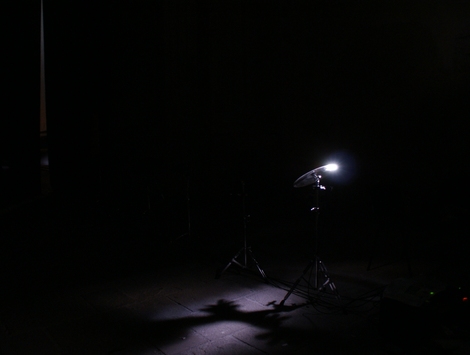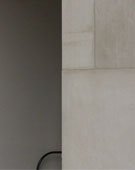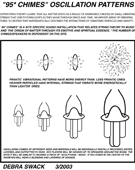An external camera flash is located underneath each drum cymbal, two centimeters away from it. When triggered, it produces an intense luminosity that literally hits the cymbal, producing a soft percussive sound.
Full Description
An external camera flash is located underneath each drum cymbal, two centimeters away from it. When triggered, it produces an intense luminosity that literally hits the cymbal, producing a soft percussive sound. The work is installed in a preferably dark and quiet space.
The installation of this work in Ex-Teresa (Transitio, DF Mexico, 2011) considered the diverse particularities of this former chapel of the Church of Santa Teresa built in 1678. Due to its antiquity and earthquake damage, the whole place is tilted to one side, therefore, the cymbals were disposed in the same inclination so that the sound could be projected symbolically in the same direction within the space. The composition was made regarding with the cymbal’s different tone colors and their distribution throughout the space, since the ones located closer to the walls resonated with more intensity.
Technique inspired in the Photoelectric Effect (wave-particle duality) Museum of Science and Technology Residency, Chile 2005
Work metadata
- Year Created: 2011
- Submitted to ArtBase: Wednesday Sep 25th, 2013
- Original Url: http://www.pafn.net/2011/12/29/untitled-2/
-
Work Credits:
- Ariel Bustamante, primary creator
Take full advantage of the ArtBase by Becoming a Member
Artist Statement
Some possible physical reasons that might help to understand how sound is generated in the work can be summarized as follows: the first explanation is related to the nature of light, which possesses characteristics related to both waves and particles (photons); these latter elements would be transferring their momentum by colliding with the cymbal’s atoms, causing an audible vibration. It is also possible that this sound effect is produced by expanding air due to the heat generated by the flash. Or a third possibility: an electromagnetic pulse generated by the flash could be responsible for altering the cymbal. The truth is that there is a conversion of the energies involved, which then translates into sound. The effect, more than empirically proving the scientific operation of the event, is intended to expand imaginary thinking and facilitate more subjective reflections of the deep nature of light, sound, and the relationship between these two.
The darkness in the place where the installation is located creates an optic resistance that causes the viewer to rely mainly on his or her hearing. Through the cymbal’s momentary illumination, which is both the source that produces the sound and the visual gesture that announces its origin, the quality of hearing is incremented, since this expands the amount of information that accompanies the sonic event, improving attention and consequentially creating a special setting within which to perceive the sounds that are generated.
The installation of this work in Ex-Teresa (Transitio, DF Mexico, 2011) considered the diverse particularities of this former chapel of the Church of Santa Teresa built in 1678. Due to its antiquity and earthquake damage, the whole place is tilted to one side, therefore, the cymbals were disposed in the same inclination so that the sound could be projected symbolically in the same direction within the space. The composition was made regarding with the cymbal’s different tone colors and their distribution throughout the space, since the ones located closer to the walls resonated with more intensity.





